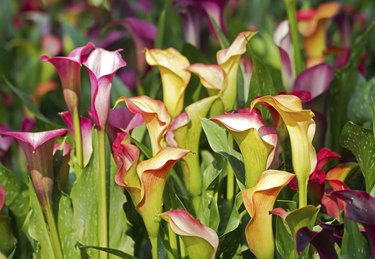
A calla lily (Zantedeschia spp.) grows from 1 1/2 to 4 feet tall with arrowhead-shaped leaves and a large colorful bract that wraps around a spike called the spadix. That spadix contains the actual tiny flowers. Perennial in U.S. Department of Agriculture plant hardiness zones 7 through 11, most calla lilies -- except Zantedeschia aethiopica types -- drop into dormancy in fall, at which time their rhizomes can be stored indoors in colder zones and replanted the following spring. When harvesting seeds from toxic calla lily berries, be careful not to get their sometimes irritating juice on your skin.
Select the Seeds
Video of the Day
When choosing seeds to harvest, keep in mind that hybrids don't come true from seed. That means the plants grown from those seeds won't be identical to the parent plant. A species type such as the common calla (Calla aethiopica, USDA zones 7 through 11) should come true from seed, if it isn't growing near other callas with which it may have crossed.
Video of the Day
A calla lily that has been pollinated will eventually form a 2- to 5-inch-long cluster of kernel-like berries at its center. As the kernels grow larger, their weight will bend the stem to the ground. Allow the kernels to ripen until they are soft and yellowish.
Harvest Your Seeds Safely
For safety's sake, wear plastic gloves while harvesting the seeds. Extract them underwater to dilute the kernels' possibly irritating juice and to prevent any of it from spattering onto your skin.
First, fill a dishpan with several inches of lukewarm water. Holding the cluster of kernels under the surface of the water, pluck a kernel from the cluster with your gloved hand. Keeping your hand and the kernel underwater, squeeze that kernel until it squirts a seed or seeds into the water. There can be one to five seeds in each kernel, usually measuring from about 1/8 to 3/16 inch in diameter. Continue plucking and squeezing kernels underwater until you have harvested as many seeds as you need.
Plant the Seeds
Place the dishpan in a safe place out of the reach of children and pets and allow the seeds to soak for 24 hours. Then fill 3-inch pots with a mix of 1 part potting soil and 1 part sand or perlite. Sow one seed in each pot, covering it with 1/4 inch of the mix.
Calla lily seeds often take from one to three months to germinate, though fresh ones can sprout in as little as four days. To keep their mix damp during that time, place the pots inside zipper-type plastic bags, zipping the bags shut, and placing the pots on a partially shaded windowsill or under a grow light at a temperature between 60 and 77 degrees Fahrenheit.
Growing Your Seedlings
Once the seeds begin to sprout, remove the bags, leaving the pots under the grow light or on a sunny windowsill. For Calla aethiopica types, use a windowsill where they receive sun only during the morning and shade during the afternoon. Keep the calla lily seedlings growing in pots, moving them outdoors during the summer, until their rhizomes are about 1/2 inch in diameter. After that, you can handle them as you would adult rhizomes, though they probably won't bloom until they are at least three years old.
In zones where the lilies are hardy, set the rhizomes in the ground in fall or spring. Plant them 4 inches deep and 1 foot apart for Calla aethiopica types, 2 inches deep and 8 inches apart for other varieties.
In colder zones, you can keep the rhizomes of those other varieties dormant over the winter. To do so, allow the soil in their pots to dry out until the leaves die back, and store the pots in a cool, dark place all winter. Begin watering them again in spring. The rhizomes of Calla aethiopica types should be kept growing all winter in a pot on a partially shaded windowsill and not allowed to dry out.